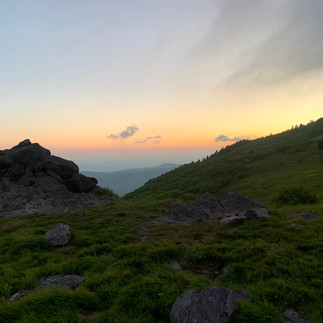6/8/20 Day 33: Buzzard Rock (491.5) to Brook Campsites (511.7)
- Adam Stevenson

- Nov 6, 2021
- 3 min read


Monday, June 8 7:30 pm 20.2 mi White Top, Greyson Highlands ponies
AT 491.5 Buzzard Rock → AT 511.7 Brook Campsites
Weather: Warm, partly overcast partly sunny
Trail Conditions: Crowded, lots of horse and cow poo to dodge, VERY rocky and rooty day
My Condition: Body is feeling it today. Despite draw of seeing ponies, felt lethargic and never quite got in rhythm. Right shin was painful today – it seems the pain is just bouncing around from part to part. Advil night.
Amazing sunset last night, TERRIBLE night of sleep. The wide open mountaintop expanse became a wind tunnel, and although I didn’t blow away it certainly sounded like I was in a rocketship about to take off all night. Chatted with Kirsten, a weekend hiker from North Carolina, about my thru hike as the sun approached the horizon. Was hiking by 6:30 today, yet I feel like I barely hit 20 miles despite the long day. I’ll blame it on the PONIES! They were incredible – I saw my first 2 ponies with 2 men before Thomas Knob shelter. One was laying down looking off into the distant landscape while the other treated one of the men like a salt lick. Rather than stop and take a picture or pet the horses, I pushed on. The Thomas Knob shelter area was overrun with horses, and I had the area all to myself. At one point, I had 4 different horses surrounding me, licking all the salty sweat from my arms and legs, and I wasn’t sure if I’d be able to escape. The next set of ponies was still very friendly, though more interested in eating grass as I’d just been licked clean. The further I got from the shelter, the more skittish and introverted the ponies became – if you approached, they’d step away. Move to the side, they’d turn the other way. Young ponies, older ones, spotted ponies, solid ones, long haired manes and tails, dreadlocked – I’ve never had a hiking experience like it. Saw someone riding their own saddled horse in a no horses area (2nd time I’ve seen this during hike) and it was SO MUCH BIGGER than any of the wild horses. Saw cows and longhorns too!
Post Trail Analysis
Although my ankle troubles seem to have started before now, I may have further aggravated the injury today. I remember one particular bad step where my foot landed fully extended and I felt jarring pain shoot through my Achilles. That is of little note in the grand scheme of today’s action, however. This remains one of the more memorable days of hiking I’ve ever experienced. It is actually quite frightening to be swarmed by a pack of kind, tenderhearted, salt-seeking ponies. I knew I’d need to push my way out eventually to continue on hiking, and I had no idea how they’d take that. Young ponies, well fed ponies, a pony hobbling on an overgrown hoof, I was lucky enough to see dozens of them. The Grayson Highlands have some interesting history, which I learned about from the various signage. The first pioneers to the area found much of the land thick with virgin forests except the “bald” areas atop Whitetop and Elk Garden. It was not long before the commercial value of the timber was recognized and logging operations began. With all the open areas available after the logging, farmers soon moved in. Since the high country offered difficult access and very short growing seasons, the lands were used for grazing livestock. In the late 1960s, the Forest Service began buying land for the Mount Rogers National Recreation Area. Land managers found that, left unattended, the open high country soon re-seeded and began to fill with trees and shrubs. Ponies were introduced to graze the high country and keep the land open for both scenic and recreational uses. These ponies are hardy enough to survive the harsh winter and provide visitors with enjoyment. Each year the ponies are rounded up, checked to ensure good health, and some ponies are sold to manage the herd size. Hiking northbound, you eventually come across an area known as “The Scales” which now serves as a camping spot with a restroom. Farmers grazing cattle in these mountains used the area as a place to gather, weigh, and sell their cattle. Because the cattle weighed less after walking down the mountain, farmers quickly learned that their animals brought the best price with their “high country” weight, and would use this area as a place to gather and exchange.
































































































































Comments